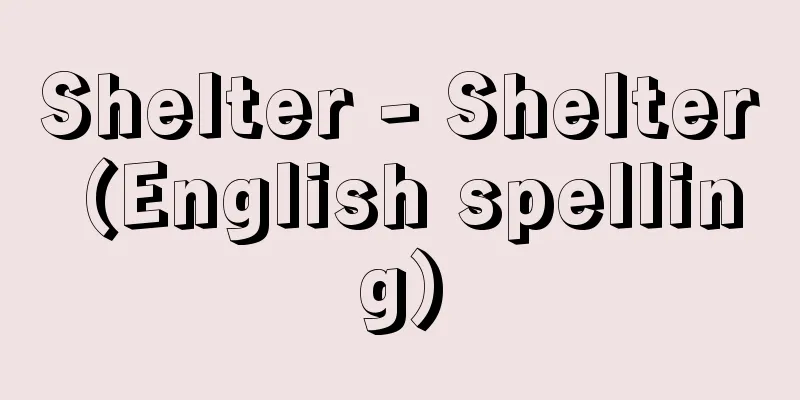Shelter - Shelter (English spelling)

|
A shelter. Generally refers to a nuclear shelter that provides protection against nuclear explosions. It is considered important as a passive defense against nuclear attacks. The main type of shelter is a fallout shelter to protect against radioactive fallout. During a nuclear explosion, fallout is dust containing fission products and induced radioactive materials that rises into the atmosphere and falls immediately after the explosion or after floating in the atmosphere. It emits various types of radiation, but since the radiation decreases over time, fallout shelters are designed to protect against this period. It is necessary to have air purification equipment and supplies and equipment necessary for survival. Two weeks after a nuclear attack, radiation levels will drop to one-thousandth of their original level, so the goal is to ensure evacuation during this time, but the cost of building shelters is high, and only a small number of wealthy people will be able to survive. Furthermore, survival after two weeks cannot be guaranteed. Also, shelters near the hypocenter will be destroyed. Blast shelters are intended to protect against the blast, heat, and radiation of a nuclear explosion. They must be sturdy underground structures, and are only built for important military facilities and central government agencies. However sturdy they are, they cannot withstand repeated attacks. The only way to protect ourselves from nuclear damage is to prevent nuclear war and eliminate nuclear weapons. [Haruo Fujii] Source: Shogakukan Encyclopedia Nipponica About Encyclopedia Nipponica Information | Legend |
|
避難所のこと。一般に核爆発に対する防護機能をもつ対核シェルターを意味する。核攻撃に対する消極的防衛の手段として重視されている。シェルターのおもなものは放射性フォールアウト(降下物)から防護するためのフォールアウト・シェルターである。フォールアウトは、核爆発の際、核分裂生成物や誘導放射性物質を含む塵(ちり)が大気中に舞い上がり、爆発直後ないし大気中を浮遊したのち降下してくるもので、各種の放射線を出すが、放射線は時間の経過とともに減少するので、この間の防護を図ろうというのがフォールアウト・シェルターである。空気浄化装置と生存に必要な物資、設備を整備しておく必要がある。 核攻撃後2週間たてば放射能が1000分の1に減少するので、この間の避難を確保することが目標とされているが、建設費が高く、富裕な一部の者だけが生き残れるにすぎない。しかも2週間以後の生存は保障できない。また爆心地近くではシェルターそのものが破壊されてしまう。 核爆発による爆風や熱線、放射線からの防護を目的とするのはブラスト(爆風)・シェルターである。これは堅固な地下構造物であることを要し、重要な軍事施設や政府中枢機関用のものが建設されているにすぎないが、どれほど堅固であっても反復攻撃に耐えられない。核被害から身を守る方法は、核戦争を防ぎ、核兵器をなくす以外にないのである。 [藤井治夫] 出典 小学館 日本大百科全書(ニッポニカ)日本大百科全書(ニッポニカ)について 情報 | 凡例 |
<<: Shelta Thari - Shelta language (English spelling)
Recommend
Bossa Nova
A new form of samba that originated in Brazil in t...
Audio, JBC - Audio
… Gouthieres was a neoclassical caster at the end...
Morrigan
Danu was the goddess of fertility and wealth, Lug...
Pater, Walter Horatio
Born: August 4, 1839, London [Died] July 30, 1894....
Ritual - Gishi
...A court ceremonial book from the early Heian p...
Reinhardt, Max
Born: September 9, 1873 in Baden [Died] October 31...
Agram
...The capital of the Republic of Croatia, in nor...
Uilta people - Uilta; Ul'chi
An ethnic minority living in the northeastern and ...
Wachi [town] - Wachi
A former town in Funai-gun, central Kyoto Prefectu...
Reḍā Khan (English spelling) Reda Khan
…Reigned 1925-41. A former Iranian Cossack soldie...
imbat
…Most common from May to August. imbat A sea bree...
Visitation Transportation - Soap Transportation
This refers to a defendant or suspect in custody m...
Shigiyaki (Shigiyaki) - Shigiyaki
Another name for eggplant miso dengaku. Its Edo na...
Ishin Suden - Ishin Suden
A Rinzai sect monk in the early Edo period. His p...
Even point - Guten
〘noun〙 A point in a mathematical problem where the...









